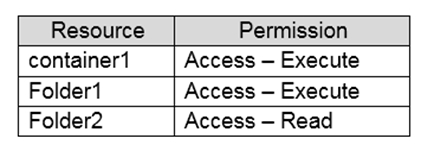

You have an Azure subscription linked to an Azure Active Directory (Azure AD) tenant that contains a service principal named ServicePrincipal1. The subscription contains an Azure Data Lake Storage account named adls1. Adls1 contains a folder named Folder2 that has a URI of https://adls1.dfs.core.windows.net/ container1/Folder1/Folder2/.
ServicePrincipal1 has the access control list (ACL) permissions shown in the following table.
You need to ensure that ServicePrincipal1 can perform the following actions:
✑ Traverse child items that are created in Folder2.
✑ Read files that are created in Folder2.
The solution must use the principle of least privilege.
Which two permissions should you grant to ServicePrincipal1 for Folder2? Each correct answer presents part of the solution.
NOTE: Each correct selection is worth one point.
kl8585
Highly Voted 2 years, 5 months agoSr18
10 months agoyogiazaad
2 years, 3 months agobokLuci
Highly Voted 2 years, 5 months agoLewiasskick
1 year, 2 months agoKauK
Most Recent 4 months agolearnwell
9 months, 2 weeks agoSouvik_79
9 months, 2 weeks agoDusica
11 months, 3 weeks agoAlongi
1 year agoGman1986
1 year, 1 month agoMarkJoh
1 year, 3 months ago[Removed]
1 year, 3 months agokkk5566
1 year, 7 months ago[Removed]
1 year, 8 months ago[Removed]
1 year, 9 months agoauwia
1 year, 9 months agoesaade
2 years, 1 month agoyogiazaad
2 years, 3 months agoAzureJobsTillRetire
2 years, 4 months ago